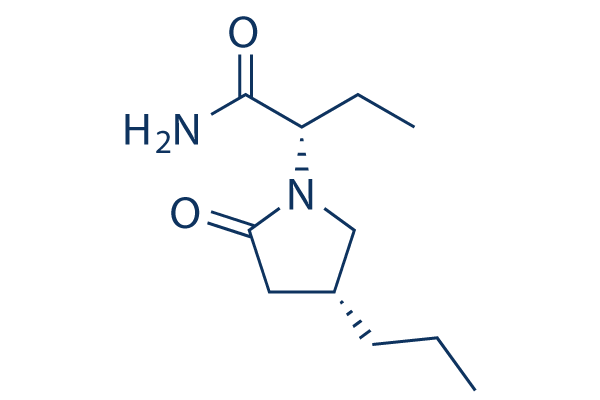
In vitro: Brivaracetam in vitro exerts a dose-dependent cytotoxic effect on various glioma cell lines and this effect is concomitant with the modulation of a number of miRNAs.
In vivo: Brivaracetam reduces spike-wave discharges in Alzheimer's disease mice and reverses impairments in spatial memory in APP/PS1 mice. Human pharmacology studies have shown that brivaracetam has a half-life of approximately 8 h and does not vary with the administered dose. It has nearly complete bioavailability. Plasma protein binding is weak (20%), the volume of distribution, 0.6 l/kg, being close to that of total body water. Brivaracetam is primarily metabolized via hydrolysis of the acetamide group and CYP2C8-mediated hydroxylation. Its metabolites are not pharmacologically active. Brivaracetam is neither mutagenic nor clastogenic. Single oral doses of brivaracetam, up to 1000 mg and repeated oral doses up to 800 mg/d b.i.d., are well-tolerated in healthy volunteers and in patients. Treatment-emergent adverse events are mostly CNS-related and transient, and their intensity is usually mild or moderate. Repeated intake of the drug reduces their incidence.
| Cell Experiment | |
|---|---|
| Cell lines | U87MG cell line, SW1783 and T98G cells |
| Preparation method | Cytotoxicity of BRV was studied by cell proliferation assay. |
| Concentrations | 0-2500 μM |
| Incubation time | 0-24-48-72 h |
| Animal Experiment | |
|---|---|
| Animal models | Transgenic Alzheimer’s disease (AD) mice |
| Formulation | normal saline |
| Dosages | 10 mg/kg |
| Administration | i.p. |
| Molecular Weight | 212.29 |
| Formula | C11H20N2O2 |
| CAS Number | 357336-20-0 |
| Solubility (25°C) | 10 mM in DMSO |
| Storage |
Powder -20°C 3 years ; 4°C 2 years In solvent -80°C 6 months ; -20°C 1 month |
| Species | Mouse | Rat | Rabbit | Guinea pig | Hamster | Dog |
| Weight (kg) | 0.02 | 0.15 | 1.8 | 0.4 | 0.08 | 10 |
| Body Surface Area (m2) | 0.007 | 0.025 | 0.15 | 0.05 | 0.02 | 0.5 |
| Km factor | 3 | 6 | 12 | 8 | 5 | 20 |
| Animal A (mg/kg) = Animal B (mg/kg) multiplied by | Animal B Km |
| Animal A Km |
For example, to modify the dose of Compound A used for a mouse (20 mg/kg) to a dose based on the BSA for a rat, multiply 20 mg/kg by the Km factor for a mouse and then divide by the Km factor for a rat. This calculation results in a rat equivalent dose for Compound A of 10 mg/kg.
[3] Philipp von Rosenstiel. Neurotherapeutics. Brivaracetam (UCB 34714)
| Related Sodium Channel Products |
|---|
| ASN008
ASN008 is a permanently positively charged sodium channel blocker. |
| Psalmotoxin 1
Psalmotoxin 1 (PcTx1) is a protein toxin that can bind at subunit-subunit interfaces of acid-sensing ion channel 1a (ASIC1a). |
| Jingzhaotoxin-III
Jingzhaotoxin-III is a potent and selective blocker of Nav1.5 channels, with an IC50 of 348 nM, and shows no effect on other sodium channel isoforms. |
| Huwentoxin-IV
Huwentoxin-IV is a potent and selective sodium channel blocker, inhibits neuronal Nav1.7, Nav1.2, Nav1.3 and Nav1.4 with IC50s of 26, 150, 338 and 400 nM, respectively. |
| Phrixotoxin 3
Phrixotoxin 3 is a potent blocker of voltage-gated sodium channels, with IC50s of 0.6, 42, 72, 288, 610 nM for NaV1.2, NaV1.3, NaV1.4, NaV1.1 and NaV1.5, respectively. |


Products are for research use only. Not for human use. We do not sell to patients.
© Copyright 2010-2023 AbMole BioScience. All Rights Reserved.
